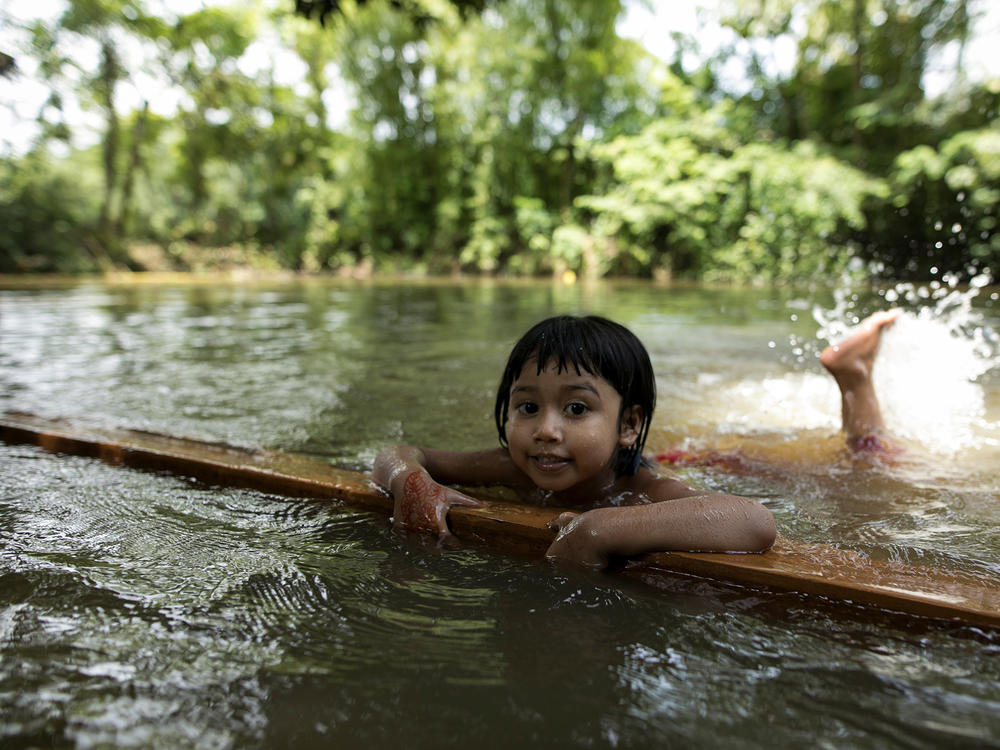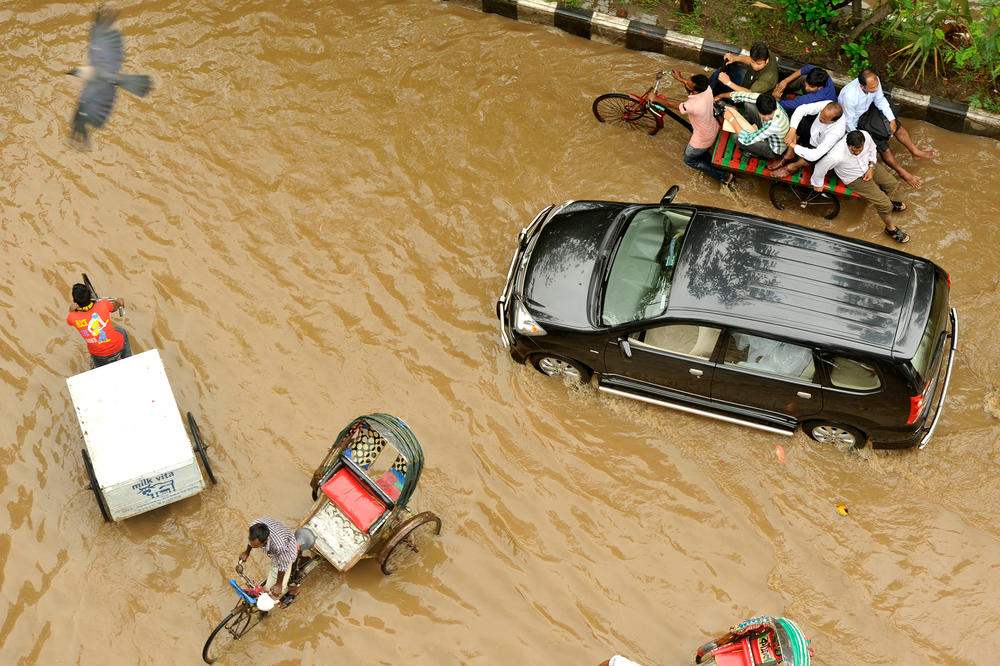Section Branding
Header Content
The U.N. Takes Aim At A 'Silent Epidemic' — Drowning
Primary Content
An underrecognized public health issue kills more than 235,600 people every year worldwide. It's not a disease. It's not a health condition.
It's drowning.
Even as severe new outbreaks of the COVID-19 pandemic take hold in places like India and parts of the Middle East, this week the U.N. passed a resolution that commits member state governments to making greater efforts to combat death by drowning — one of the top ten causes of death for children between the ages of 5 and 14.
Under the resolution, which was put forth by Bangladesh and Ireland and co-sponsored by 79 member states, signees agree to raise public awareness and develop a national drowning reduction strategy with measurable targets, among other efforts. The resolution also names July 25 as annual U.N. Day for drowning prevention.
Drowning deaths are disproportionately distributed around the globe. According to the "Global Report on Drowning," issued by the World Health Organization in 2014, over 90% of drowning deaths occur in low- and middle-income countries. The report also states that the drowning rates in low- and middle-income countries are nearly 3.5 times higher than in high-income countries. The U.N. resolution notes that Africa experiences the highest rates and that the Asian region carries the burden of the greatest numbers of deaths.
To understand the context and potential outcomes for this resolution, and to learn what steps are already being taken in one of the countries most impacted, we spoke with Dr. Aminur Rahman, drowning prevention director at the Bangladesh-based Centre for Injury Prevention and Research (CIPRB).
This conversation has been edited for length and clarity.
In the midst of this horrifying global pandemic, how did the U.N. decide this issue is important enough to warrant a resolution?
This pandemic is a new thing. It's only been around for the past year and a half. Drowning is a silent epidemic that's been in place for ages. This U.N. resolution is a wake-up call for all nations that don't have lifesaving national strategies in places.
And of course drowning is still happening during the pandemic. As a public health expert in this area I suspect it's even getting worse. Now that schools are closed the children are at home, and the parents can't always supervise them sufficiently.
Why are drowning deaths still such a daunting public health problem? What are the biggest barriers?
Right now people in low- and middle-income countries generally don't have the skills to rescue a drowning victim. They probably haven't learned how to swim or how to perform CPR. Even medical professionals at hospitals are often not properly trained to handle drowning cases.
The biggest barrier in Bangladesh is that there's a widespread perception that nothing can be done — that if someone drowns it's God's will. So the lack of awareness that this is an issue of great magnitude that can be combated is a big problem.
What strategies are being utilized to prevent drowning?
My colleague and I conducted surveys [of hundreds of thousands of people] here in Bangladesh and we found that about 80% of the drowning deaths here occur for children under 10 years old. For the older age group, ages 5 through 9, we are teaching swimming in local ponds. We also teach them how to do a "dry rescue" for other children from the safety of the bank: throwing them a stick or a rope or something for them to float on and then calling for help. After a child goes through our program, SwimSafe, they have a 96% less chance of drowning. [His organization reports that as of 2014 340,000 children have taken part in the program.]
One 6-year-old child who attended our program was caught with his family in the flood of 2014. Their courtyard completely flooded, and they put all of their belongings and family members in a boat, and it capsized. The boy was able to swim for some distance to safety, completely independently. The rest of the family survived as well.
Another one of our graduates is now competing in national swimming competitions. He could be at the Olympics someday, who knows!
Your research shows that drowning accounts for 42% of all deaths of children ages 1 through 4 in Bangladesh. What can be done for children in this age range?
Better supervision. It's like a vaccination against drowning.
We established community daycare centers where children ages 1 through 4 can go from 9 a.m. till 1 p.m. (the hours of highest risk, while parents are most likely to be distracted by household activities) where they also participate in early childhood stimulation activities that help them with linguistic, emotional and cognitive development. Children in these centers have an 80% lower chance of drowning. Even some vaccines are only 75-80% effective, so we consider this a very useful intervention.
Since we started in 2012 we have created 2,500 daycare centers in 10 subdistricts. But we are still reaching only a very small percentage of the 163 million people who live in this country. We are working with our institutional partners to scale up.
You mentioned CPR earlier. Is that something you teach as well?
We teach CPR to children ages 7 and up. We find that even children this young can learn the skills quite well and utilize them when needed.
One of the girls who learned CPR, a 7 year old, had a younger brother of about 3 years old who fell into a pond. Here in Bangladesh if you walk about 20 meters you will find a water body that families use for household chores, and the children can slip away while the parents aren't looking. An older person found the child and dragged him out from the water.
The adult was going to use his region's typical, but harmful, strategies to revive the boy, like forcing him to vomit. But the girl had the adult lay her brother on the ground. She gave him five rescue breaths and started compressing the chest. She saved her little brother. Her parents were really happy.
Does this work hold personal significance for you?
When I was in grade 10 one of my classmates, who was three years junior to me, drowned during a school picnic. He was an only child. Because I was the school captain I had to organize a mourning session in the school and that was really painful for me. That was my first experience as an eyewitness to a dead body.
In 2000 I came in contact with the man who is now my boss at the CIPRB, Dr. Fazlur Rahman. His Ph.D. research found that in one subdistrict of Bangladesh 25% of children's deaths were from drowning. I asked him what the national figure was and he said no one knows. That triggered me. I immediately thought back to that childhood experience.
My colleague and I found that 30,000 children under 18 in Bangladesh die due to injury, and over half of them from drowning. We thought: We need to do something. In Bangladesh there is a big institute called the International Centre for Diarrhoeal Disease Research. It's very renowned. People all over the world come here to learn about diarrhea and its control measures. We identified that in 2004-5 there were 3,500 annual deaths due to diarrhea. Why should there not be a center that could deal with preventing 30,000 deaths? My colleague and I approached the government but they would not fund it. So we left our jobs and developed it independently. My education, my work and my personal story all relate to each other, and I'm passionate in doing drowning prevention.
Emily Vaughn is a freelance reporter and audio producer based in Washington, D.C. Her Twitter account is @emilyannevaughn
Copyright 2021 NPR. To see more, visit https://www.npr.org.


